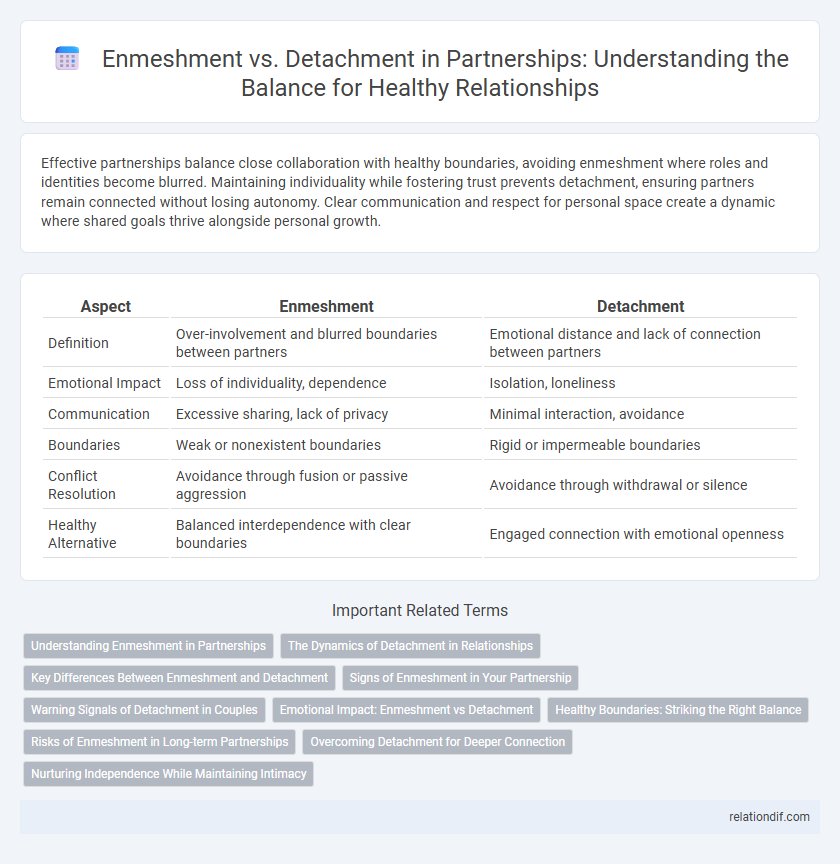Effective partnerships balance close collaboration with healthy boundaries, avoiding enmeshment where roles and identities become blurred. Maintaining individuality while fostering trust prevents detachment, ensuring partners remain connected without losing autonomy. Clear communication and respect for personal space create a dynamic where shared goals thrive alongside personal growth.
Table of Comparison
| Aspect | Enmeshment | Detachment |
|---|---|---|
| Definition | Over-involvement and blurred boundaries between partners | Emotional distance and lack of connection between partners |
| Emotional Impact | Loss of individuality, dependence | Isolation, loneliness |
| Communication | Excessive sharing, lack of privacy | Minimal interaction, avoidance |
| Boundaries | Weak or nonexistent boundaries | Rigid or impermeable boundaries |
| Conflict Resolution | Avoidance through fusion or passive aggression | Avoidance through withdrawal or silence |
| Healthy Alternative | Balanced interdependence with clear boundaries | Engaged connection with emotional openness |
Understanding Enmeshment in Partnerships
Enmeshment in partnerships refers to blurred boundaries where individual identities and emotions become overly intertwined, often leading to loss of autonomy and increased dependency. This dynamic can create challenges in maintaining personal space and healthy communication, as partners struggle to differentiate their needs and feelings. Recognizing enmeshment allows couples to establish clearer boundaries, promoting emotional independence while preserving intimacy.
The Dynamics of Detachment in Relationships
Detachment in relationships involves establishing healthy emotional boundaries that prevent enmeshment, allowing partners to maintain their individuality while fostering mutual respect. This dynamic promotes personal growth and reduces codependency by encouraging independent decision-making and self-awareness. Effective detachment balances connection with autonomy, enhancing trust and the overall stability of the partnership.
Key Differences Between Enmeshment and Detachment
Enmeshment in partnerships involves blurred boundaries and excessive emotional involvement, leading to a loss of individual autonomy, whereas detachment is characterized by emotional distance and a lack of connection between partners. Enmeshed relationships often result in dependency and difficulty in establishing personal identity, while detached relationships may cause isolation and lack of intimacy, impacting mutual trust and communication. Key differences include the presence of overwhelming closeness in enmeshment versus emotional withdrawal in detachment, affecting relationship satisfaction and overall emotional health.
Signs of Enmeshment in Your Partnership
Signs of enmeshment in your partnership include blurred boundaries where individual identities and personal space are compromised, leading to a lack of autonomy. Excessive emotional dependence and the inability to make decisions independently often result in constant seeking of approval from your partner. Frequent feelings of guilt or anxiety when spending time apart highlight a deeply entangled relationship dynamic.
Warning Signals of Detachment in Couples
Warning signals of detachment in couples include lack of emotional responsiveness, decreased communication frequency, and avoidance of intimacy, which often lead to growing emotional distance. Physical withdrawal, reduced eye contact, and neglecting shared activities further indicate a diminishing connection. Recognizing these signs early can help partners address issues before detachment becomes entrenched and harms the relationship.
Emotional Impact: Enmeshment vs Detachment
Enmeshment in partnerships often leads to impaired individual boundaries, causing emotional overwhelm and dependency, which can result in anxiety and loss of personal identity. Detachment, conversely, fosters emotional distance and lack of intimacy, triggering feelings of loneliness and emotional neglect. Both extremes disrupt healthy emotional connection, highlighting the importance of balanced attachment for relationship satisfaction and mental well-being.
Healthy Boundaries: Striking the Right Balance
Healthy boundaries in partnerships require balancing enmeshment and detachment by maintaining individual autonomy while fostering emotional closeness. Enmeshment can lead to loss of personal identity and dependence, whereas detachment may cause emotional distance and disconnection. Establishing clear communication, respecting personal space, and nurturing mutual support develop a secure connection that honors both partners' needs.
Risks of Enmeshment in Long-term Partnerships
Enmeshment in long-term partnerships often leads to blurred personal boundaries, causing individuals to lose their sense of identity and autonomy. This dynamic increases the risk of emotional dependence, making it difficult to address conflicts objectively or maintain healthy communication. Over time, such patterns can result in codependency, reduced relationship satisfaction, and hindered personal growth.
Overcoming Detachment for Deeper Connection
Overcoming detachment in partnerships requires intentional vulnerability and consistent emotional engagement to foster trust and intimacy. Recognizing and addressing patterns of emotional withdrawal can break cycles of isolation, enabling partners to rebuild a deeper connection. Practice of empathy, active listening, and shared experiences enhance emotional presence and diminish detachment.
Nurturing Independence While Maintaining Intimacy
Balancing enmeshment and detachment is crucial for nurturing independence while maintaining intimacy in a partnership. Healthy relationships foster mutual support and personal growth, where partners respect boundaries yet remain emotionally connected. This balance enhances trust, encourages individual autonomy, and deepens emotional intimacy for long-term relationship success.
Enmeshment vs Detachment Infographic

 relationdif.com
relationdif.com